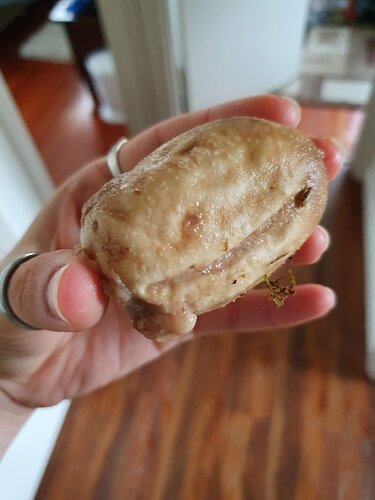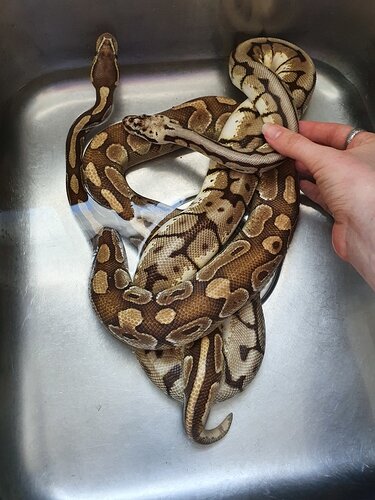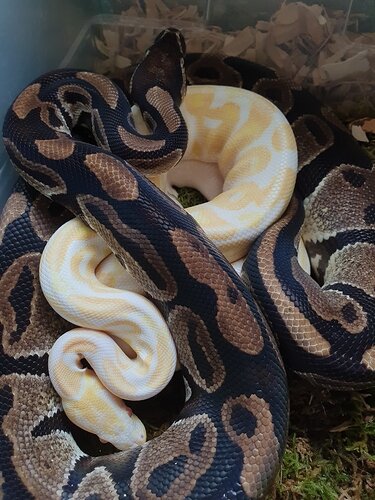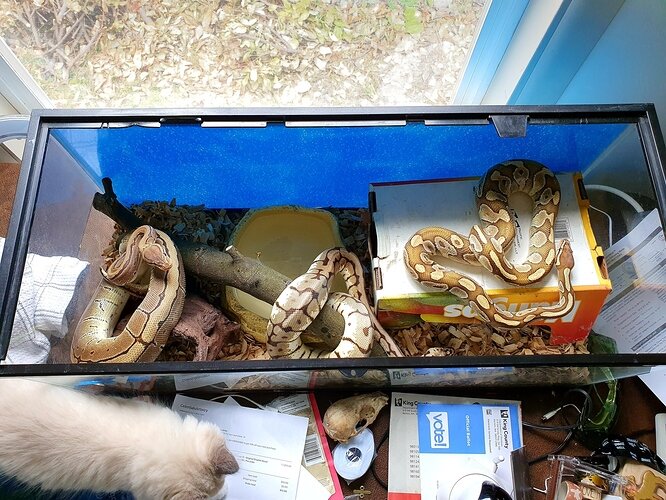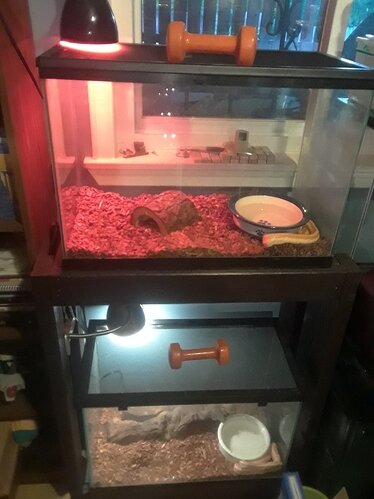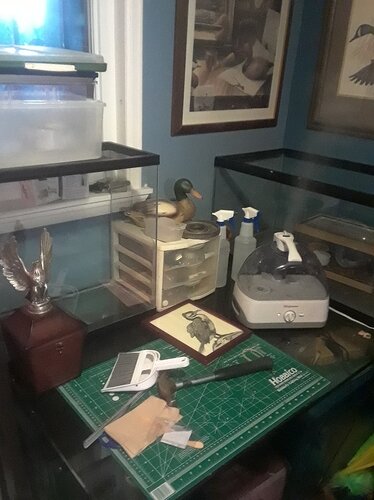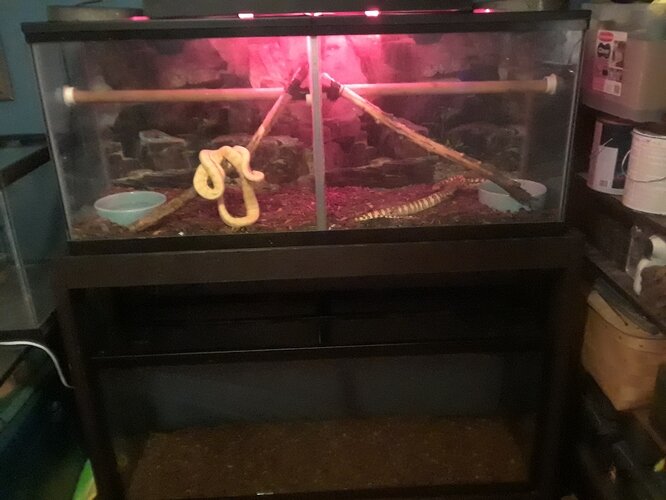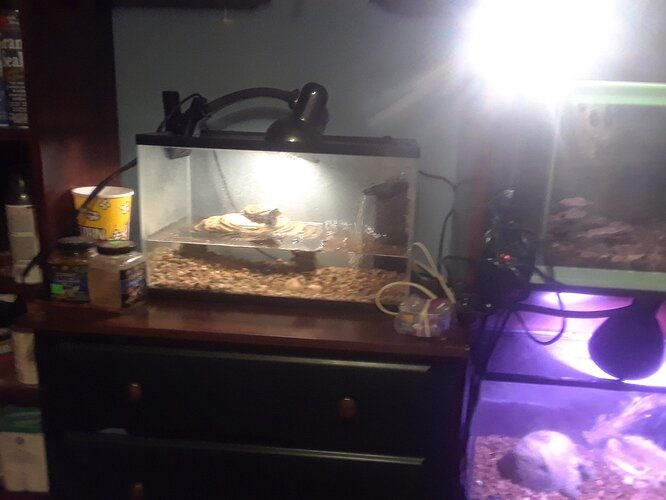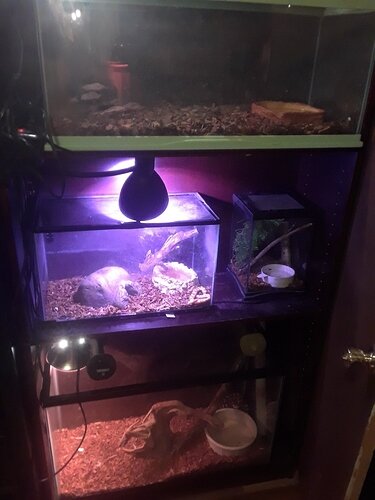Good Afternoon All,
My first post and very excited to be part of the community!
So, I’ve taken over my brother’s 5 ball pythons, as he has over 30 snakes and finds BPs to be the most finicky eaters of the lot. One of his BPs is gravid, so I’ve set up an impromptu incubator, as I only had a few days notice, and am eagerly awaiting the eggs. He had planned on just tossing the clutch, as the mum is a common and the father is an albino, which meant he wasn’t excited about the babies and didn’t have an incubator set up.
I loved incubating all his corn snake eggs back in the day, so I figured it wouldn’t be too hard to set up for BPs instead. I’ve done a good bit of reading, got the incubator set up, got my box in there ready with vermiculite.
So this morning, I do my usual check to see if she’s laid the eggs yet, and I find this strange egg. It’s quite large - although my hands are quite small - and was covered in a pale brown ‘mucus’ substance, that has a sticky, almost paste-like consistency. I need to get a stronger flashlight, as the one I have couldn’t shine through the egg to see if there were veins. I’m not sure if this is a slug, as most examples of BP slugs I’ve seen appear much smaller than this.
Any thoughts?
Much appreciated,
Celeste
1 Like
First of, welcome to the forum 

I can’t be much help on the egg, it looks like a misshaped slug to me but I have very minimal experience with breeding.
Hopefully @stewart_reptiles can help on that front.
You say you have taken your brother’s 5 BPs, does that include the Normal and Albino?
Feel free to share pictures of them all  we like snakes over here.
we like snakes over here.
1 Like
Thank you for the warm welcome! Always appreciated.
Yup, in all I’m taking care of his normal, albino, pinstripe, butter, and bumblebee BPs. I’ve got the three younger ones (Butter, Bumblebee, and Pinstripe) in one cage, and the mating pair in another, as that’s what he provided me with.
He has his snake colony in a large riser set up, individual tubs, heat controlled room. He tends to only feed his snakes on a once a month basis, so when the BPs aren’t eating consistently, it doesn’t take long before they’ve gone months without being fed. He’s a big proponent of underfeeding snakes rather than overfeeding.
I’ve switched them all to weekly feedings, and so far have had great success, outside of when someone is in pre-shed. I’m hoping to get them all, but especially the younger three (who are all roughly 5-7 years old) to get some proper girth and length for their age. Researching all I can to make sure that while they’re in my care, they can be happy and healthy.
Tending to these five beauties has given me the hankering to get one for myself, as eventually I’ll be giving him back his snakes. I’m contemplating maybe something like a pastel banana pied.
2 Likes
Your welcome 
You’ve joined the right place, we have a lot of friendly and knowledgeable users on here.
You have some lovely snakes there 
Don’t take this as any sort of attack, I just want you and your animals to be happy…
It seems you have been dropped in the deep end in terms of equipment/animal ratio.
As soon as possible you need to get individual enclosures, with the correct heating equipment and thermostats for each snake… I don’t know if this is already your plans or not.
If your any good with DIY then check out this rack @chesterhf made recently. It would be a perfect place to start 
5 Likes
Nah, no worries. I know what you mean.
Both of the tanks have heaters beneath the glass. My only reticence to the rack style systems is wanting to be able to see the snakes. My brother has made his own rack, which is what they previously were in.
Is there a compromise where it can still be a glass front cage so you can still see the snakes, but they can have a more controlled environment/humidity/etc? Again, my experience is mostly with his old corn snakes, which I took care off whenever he was off on deployment, so ball pythons are a new bag of tricks. I prefer the BPs in terms of temperament and activity level.
I am pretty sure high stress can lead to issues with females laying eggs. Keeping them together in such small enclosures is a good way to make them get sick/not eat because of how stressed they can get. They also can’t stay warm as much as they need to because they have to compete for the hotspot, which would lead to issue with eggs forming properly. @stewart_reptiles @wreckroomsnakes and others can definitely chime in on what is wrong with that egg, along with everything else.
1 Like
Thanks for the shoutout @eaglereptiles!
You can do individual cages with clear fronts, like these ones from Animal Plastics - TERRESTRIAL CAGES | Animal Plastics, but they’re usually pretty pricey. You’d be looking at ~$200 per snake plus thermostat. So your best bet is probably a rack at this point, or a glass tank for each snake (with it’s own heat source/thermostat)
2 Likes
Along with these options the quickest and easiest method to get them all individual enclosures is to just get tubs to put them in. BPs need a lot of cover and security, so sacrificing that just because you want to see them isn’t right. They are the opposite of a display species so unless you know what you are doing, enclosures with open sides are not good. They do also on rare occasions kill and try to eat each other (females will especially do this with small males).
3 Likes
Wonderful, thank you to everyone for chiming in! I really appreciate it.
I will check to see if my brother has additional cages laying about, so I can prevent overcrowding, and I can put additional hides and cover foliage to make them more comfortable.
The breeding female, Ka’a, and her consort, Lopez, are currently in about a 40 gallon tank, with the back and side walls closed off with insulation, so only the front glass panel is open.
The three smaller BPs are in about a 20 gallon tank, with the back wall closed off by a mural piece.
Would you say BPs should only be a single snake to a tank, or could two snakes cohabitate?
Again, I deeply appreciate everyone’s help with all of this. I’ve been spending the entire day researching enclosures and ball python needs, so I can better provide for them. I went into this just following the instructions that my brother passed on, but I can clearly see that he was using a very general rule for all his snakes and not differentiating between the breeds much. He’s got about 8 different breeds that he keeps either in the racks or a few separate cages.
1 Like
BPs should not be cohabitated under any circumstances. They only time they should ever be together is for mating. They don’t benefit from being together and more often than not they just get stressed/have a chance of killing each other. The only snakes I know of that are ok to cohab are garter snakes.
4 Likes
I’m fairly crafty/handy, I might see about making them some wood cages with glass fronts, similar to https://www.amazon.com/Storage-Chests-Reptile-Vivarium-Transport/dp/B082MWDV7H/ . Seems like it wouldn’t be too difficult to make and I could stack them with those front openings. Only foreseeable issue would be using too thick of wood for the base and having the undertank heater not able to get enough heat through.
If I am correct, wooden tanks are not well suited to BPs due to their higher humidity requirements. I also am not sure how safe it is to have a heating element near (or on) wood given it is a major fire hazard.
2 Likes
Just a suggestion, but I like to see my snakes too and I have found that you can get old aquariums for cheap or even free at thrift stores and off of craigslist. Under tank heaters for glass are cheap and readily available and when I want heat lamps I use clamp on desk lamps, also cheap at the thrift store. I could not figure out how to make a video so I took 5 pics around my snake room. The 3 empty cages are a 55 I got for $20, and a 40 breeder and a 15 tall that were free. The 55 will have a Texas Bullsnake in it soon. This room is about 10x10 and has desk space and my gun cabinet in it too so the tanks take up more room than racks but you can still fit a lot in a small space.
1 Like
Under tank heaters are cheap (sometimes, depends on the size) but good thermostats for both heat lamps and UTH are not. The cheap ones are just that, cheap. They are not reliable at all. Also, your rosy boa needs hides/cover just like BPs do. They are best kept around 85°F as well (as a hot spot), with a smaller water dish for less humidity. I would like to add that all snakes need access to at least 1 fully enclosed hide. But 2 is better so you can have one on both ends.
2 Likes
They had hides that they would not use. and they have both been soaking as it was time to shed. Male shed this morning, female still needs to. Humidity here is extra low, the room without the humidifier was at 16%. Even needing to shed the rosies have eaten better since I put in the water dishes. Same happened with my Texas long nose. supposed to be very low humidity but he did not shed or eat until I added the water dish. I monitor them carefully on a daily basis and I assure you I will change up anything that seems to cause any kind of health issue. I do appreciate the advice though.
1 Like
So regarding the egg, what did the other ones look like?
I must say I have never seen an egg like that at least not just being laid, it resemble an egg that has gone bad during incu action which is puzzling since it was just laid.
3 Likes
She laid a slug about a week ago, but she hasn’t actually laid her other 4(?) eggs yet. Still waiting to see how they come out.
1 Like
Could it be caused by stress from having them together or improper temps? Do you think the eggs are going bad inside her? And if they are she would need to see a vet at this point I would imagine. And if what @phantasm said is correct about how long it has been since she laid a slug, then she is likely egg bound from what I am aware. 
3 Likes
Is that what the slug looked like what she laid it? Or has that slug been out for a week? Or is that a new egg?
2 Likes
The photo is off the egg laid this morning. The slug that was laid the week prior was much smaller, easily half the size, and the stereotypical yellow, hard slug.
2 Likes
